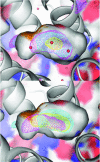Cooperative water filling of a nonpolar protein cavity observed by high-pressure crystallography and simulation
- PMID: 16269539
- PMCID: PMC1283839
- DOI: 10.1073/pnas.0508224102
Cooperative water filling of a nonpolar protein cavity observed by high-pressure crystallography and simulation
Erratum in
- Proc Natl Acad Sci U S A. 2006 Mar 21;103(12):4793
Abstract
Formation of a water-expelling nonpolar core is the paradigm of protein folding and stability. Although experiment largely confirms this picture, water buried in "hydrophobic" cavities is required for the function of some proteins. Hydration of the protein core has also been suggested as the mechanism of pressure-induced unfolding. We therefore are led to ask whether even the most nonpolar protein core is truly hydrophobic (i.e., water-repelling). To answer this question we probed the hydration of an approximately 160-A(3), highly hydrophobic cavity created by mutation in T4 lysozyme by using high-pressure crystallography and molecular dynamics simulation. We show that application of modest pressure causes approximately four water molecules to enter the cavity while the protein itself remains essentially unchanged. The highly cooperative filling is primarily due to a small change in bulk water activity, which implies that changing solvent conditions or, equivalently, cavity polarity can dramatically affect interior hydration of proteins and thereby influence both protein activity and folding.
Figures



Similar articles
-
Water in the polar and nonpolar cavities of the protein interleukin-1β.J Phys Chem B. 2010 Dec 16;114(49):16290-7. doi: 10.1021/jp108731r. Epub 2010 Nov 3. J Phys Chem B. 2010. PMID: 21047091 Free PMC article.
-
Structural and energetic responses to cavity-creating mutations in hydrophobic cores: observation of a buried water molecule and the hydrophilic nature of such hydrophobic cavities.Biochemistry. 1996 Apr 9;35(14):4298-305. doi: 10.1021/bi9524676. Biochemistry. 1996. PMID: 8605178
-
Role of cavities and hydration in the pressure unfolding of T4 lysozyme.Proc Natl Acad Sci U S A. 2014 Sep 23;111(38):13846-51. doi: 10.1073/pnas.1410655111. Epub 2014 Sep 8. Proc Natl Acad Sci U S A. 2014. PMID: 25201963 Free PMC article.
-
Hydration in protein crystallography.Prog Biophys Mol Biol. 1995;64(2-3):105-19. doi: 10.1016/0079-6107(95)00012-7. Prog Biophys Mol Biol. 1995. PMID: 8987380 Review.
-
Structure and function of water molecules buried in the protein core.Curr Protein Pept Sci. 2015;16(3):259-65. doi: 10.2174/1389203716666150227162803. Curr Protein Pept Sci. 2015. PMID: 25723549 Review.
Cited by
-
Pressure effects on collective density fluctuations in water and protein solutions.Proc Natl Acad Sci U S A. 2017 Oct 24;114(43):11410-11415. doi: 10.1073/pnas.1705279114. Epub 2017 Oct 9. Proc Natl Acad Sci U S A. 2017. PMID: 29073065 Free PMC article.
-
High-pressure protein crystal structure analysis of Escherichia coli dihydrofolate reductase complexed with folate and NADP.Acta Crystallogr D Struct Biol. 2018 Sep 1;74(Pt 9):895-905. doi: 10.1107/S2059798318009397. Epub 2018 Sep 3. Acta Crystallogr D Struct Biol. 2018. PMID: 30198899 Free PMC article.
-
Dewetting transitions in protein cavities.Proteins. 2010 Jun;78(8):1856-69. doi: 10.1002/prot.22699. Proteins. 2010. PMID: 20225258 Free PMC article.
-
Structure-function perturbation and dissociation of tetrameric urate oxidase by high hydrostatic pressure.Biophys J. 2010 May 19;98(10):2365-73. doi: 10.1016/j.bpj.2010.01.058. Biophys J. 2010. PMID: 20483346 Free PMC article.
-
Temperature artifacts in protein structures bias ligand-binding predictions.Chem Sci. 2021 Jul 13;12(34):11275-11293. doi: 10.1039/d1sc02751d. eCollection 2021 Sep 1. Chem Sci. 2021. PMID: 34667539 Free PMC article.
References
-
- Dill, K. A. (1990) Biochemistry 29, 7133–7155. - PubMed
-
- Eriksson, A. E., Baase, W. A., Zhang, X. J., Blaber, M., Baldwin, E. P. & Matthews, B. W. (1992) Science 255, 178–183. - PubMed
-
- Zhang, L. & Hermans, J. (1996) Proteins 24, 433–438. - PubMed
-
- Buckle, A. M., Cramer, P. & Fersht, A. R. (1996) Biochemistry 35, 4298–4305. - PubMed
Publication types
MeSH terms
Substances
Associated data
- Actions
- Actions
- Actions
- Actions
- Actions
- Actions
- Actions
- Actions
- Actions
- Actions
Grants and funding
LinkOut - more resources
Full Text Sources
Other Literature Sources

